No products in the cart.
A Winter Horse Ride in Mongolia
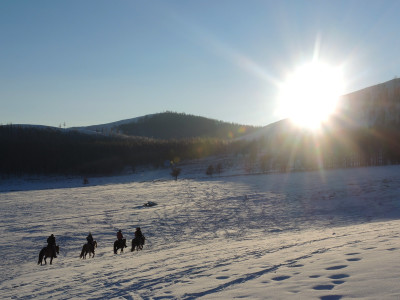
Cold Weather Horse Riding in Beautiful Winter Scenery in Mongolia
The last two weekends saw us still taking rides with guests. With snow on the ground and trees and bushes crystal covered against the backdrop of a clear blue sky, the sights were beautiful. The horses’ hoofs stir up white clouds of snow, and the breath of horses and riders turns into clouds of steam in the cold air.
Herding Horses for Winter Grazing in Mongolia
Before setting out on a winter ride in the mountains, we spot the “Stone Horse” herd way down the valley and decide to push them back a bit before they drift off too far. We herd them to an open area in a side valley, where we will be able to track their movements as they graze. It’s a nice experience for our guests to help rounding up the horses. In the winter sun, all the different color patterns of the horses stand out, and the different temperaments are on display as they move along.
Herd Structure and Horse Behavior – Equine Intelligence and Kindness
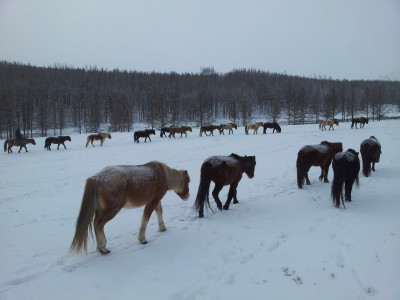
Riding behind them, the herd structure also shows very clearly. There is the big group of the Stone Horse equine establishment, the whole gang of trekking buddies that know the drill of our expeditions and each other well; still a little distant are the five new guys that joined the herd in September this year and are still working on their full integration into the herd. Yet a bit further away, the two most senior horses, Stone Horse retirees are walking along.
Watching the two senior horses, the Red Roan and Fish, is another testimony to the awareness and kindness of the animals. Fish has lost his sight in one eye, and he was grazing in a bit of a sheltered spot below a slope as we pushed the herd out of the big valley. The herd moved past on his blind side, but he eventually caught on and followed. Above, the Roan had already stopped and was watching to make sure he would come. Then he went over to him for a quick contact and off they went, Fish following close behind his caring friend. I am sure everybody who spends a lot of time with horses, and takes care of a herd, will witness behavior that speaks to the fact that they are sentient beings.
Horses find Water in the Mongolian Winter
The horses stop to paw in the snow for the frieze dried grasses preserved there, or for eating snow now that all water is frozen. With the ground frozen, most running water has ceased, and any water is covered with ice. Still, the horses pull towards the familiar sources of drinking water and they are skillful in smashing through the ice with a hoof to open a drinking hole.
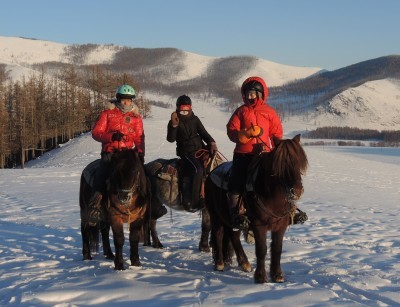
Mountain Horse Trails in the Mongolian Winter
We head to a forest trail that brings us to higher altitude. As usual, my horse “Good Boy” gives his best to get us up the mountain. He struggles and slips a bit, but still snatches bites of his favorite herbs on the go. The high slope above the forest is interspersed with patches of scree. It’s a trail we often use, it takes us to an East facing open area with great views of the surrounding heights and the winding valleys below.
Winter Forage for Mongolian Horses – Freeze Dried Grasses and Forbs
In summer, this mountain meadow is like a biodiversity hot spot, full of wildflowers, aromatic herbs and grasses among which colorful spiders span lines and webs and a multitude of beetles and other insects make their home. We always stop here, to enjoy the views and give the horses a well-deserved break for grazing. Now in winter, the meadow lies sheltered from the wind, and the dry herbs are still plentiful to make for a great equine snack time.
Mountain Views on a Winter Horse ride – Bogd Khaan and the Khentii Mountains of Mongolia
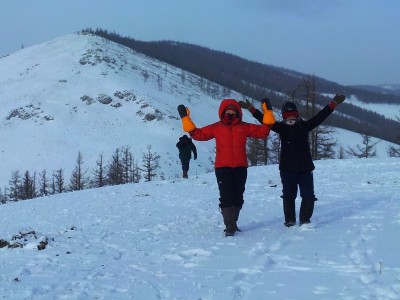
A little further up and we have reached the ridge line. To the North, we can see into the Khentii Mountains where only two months ago we were still enjoying the autumn sun, and making our way over Khavirga Pass – the high alpine pass below Altan Ulgii Mountain that we traverse on our treks into the Khentii Wilderness. To the South, the massif of Bogd Khan Mountain rises beyond the Tuul River valley. In the distant Southwest, between snow covered peaks, we can make out a haze that marks Ulaanbaatar City, and it feels very good to be out here.
A Mountain Top in the Mongolian Winter Sun
We stop at a saddle to let the horses graze, and a short hike up a near-by peak rewards us with great views and a needed warm-up. Emerging above the larch forest, the view opens and soon we reach the barren top, marked by an ovoo built of logs. These high winter pastures are now used by yaks. Little calves stay close to their mothers on the mountain side, and the whole herd of this ancient looking cattle relatives is silhouetted against the winter sky. In the ice filled atmosphere, a halo in faded rainbow colors surrounds the white sun. To the North, some blue sky is showing through the winter fog.
Snowy Slopes and Snow drifts on a Winter Ride in Mongolia
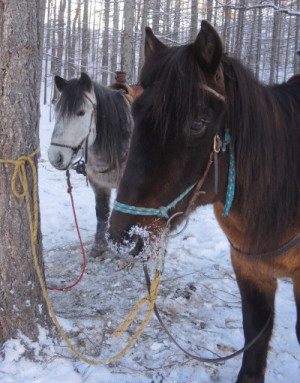
Heading back to the cabins, we ride cross country through the snow covered hills. The ground is hard and in some places slippery. The snow cover has made the rocky ground of the slopes softer and easier to traverse. Snowdrifts have filled depressions and small ravines and my horse powers through the deep snow. On a steeper mountain side that we descend I get off to walk. The slope was exposed to the wind, and its surface is a hard snow crust on which I can walk, but “Good Boy” breaks through and leaves a track of broken ice and snow behind.
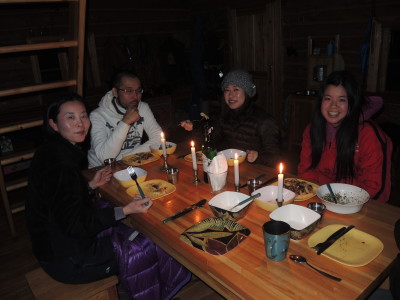
Riding Home to Warmth and Food
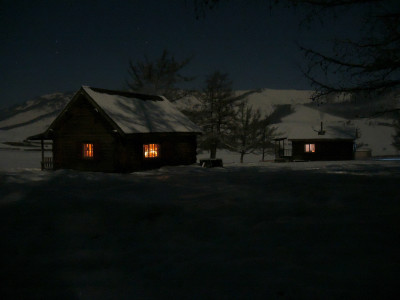
As we head back towards the cozy cabins, the horses fall into a trot and even volunteer a canter – back to a lunch break between rides during which on previous days a big pan of oats and bran soaked in water was served to the brave horses. While guests and hosts enjoy hot soup, the horses outside are equally keen to dig into their “horse muesli” that gives them extra calories.
The End of a Winter Ride in Mongolia – Horses and Riders with frosting..
Upon arrival at the cabins, we are all decorated with hoar frost – riders around their faces where hats, hoods and scarves are whitened by frozen breath. The horses’ muzzles are covered in ice crystals, their eye lashes wear a beautiful ice mascara, and after the trot home, their thick furs carry a sprinkling of white dust at the ends of the long winter hairs.
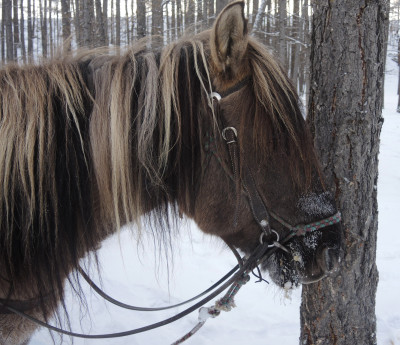
The Stone Horse Herd of Mongolian Horses – Deserving of Good Winter Care and Food
Having “Good Boy” willingly carry me up to the high ridges above the Darkhid Valley in this cold weather, only heightened my admiration for and gratitude to him. He does that after a long season of wilderness treks that had only ended four weeks ago. We really owe these guys good care with plenty of food to get them through the hard Mongolian winter. These days, the herd drifts home by mid-afternoon, hanging out near the corral where they know hay will be spread from the big pile on the other side of the fence. Stay posted for more on our winter horse care soon..
For summer and autumn riding experiences, check out our 8, 10 and 14 Day Horse Riding Treks in Gorkhi Terelj National Park and the Khentii Mountains of Mongolia .
Thanks,
Sabine


